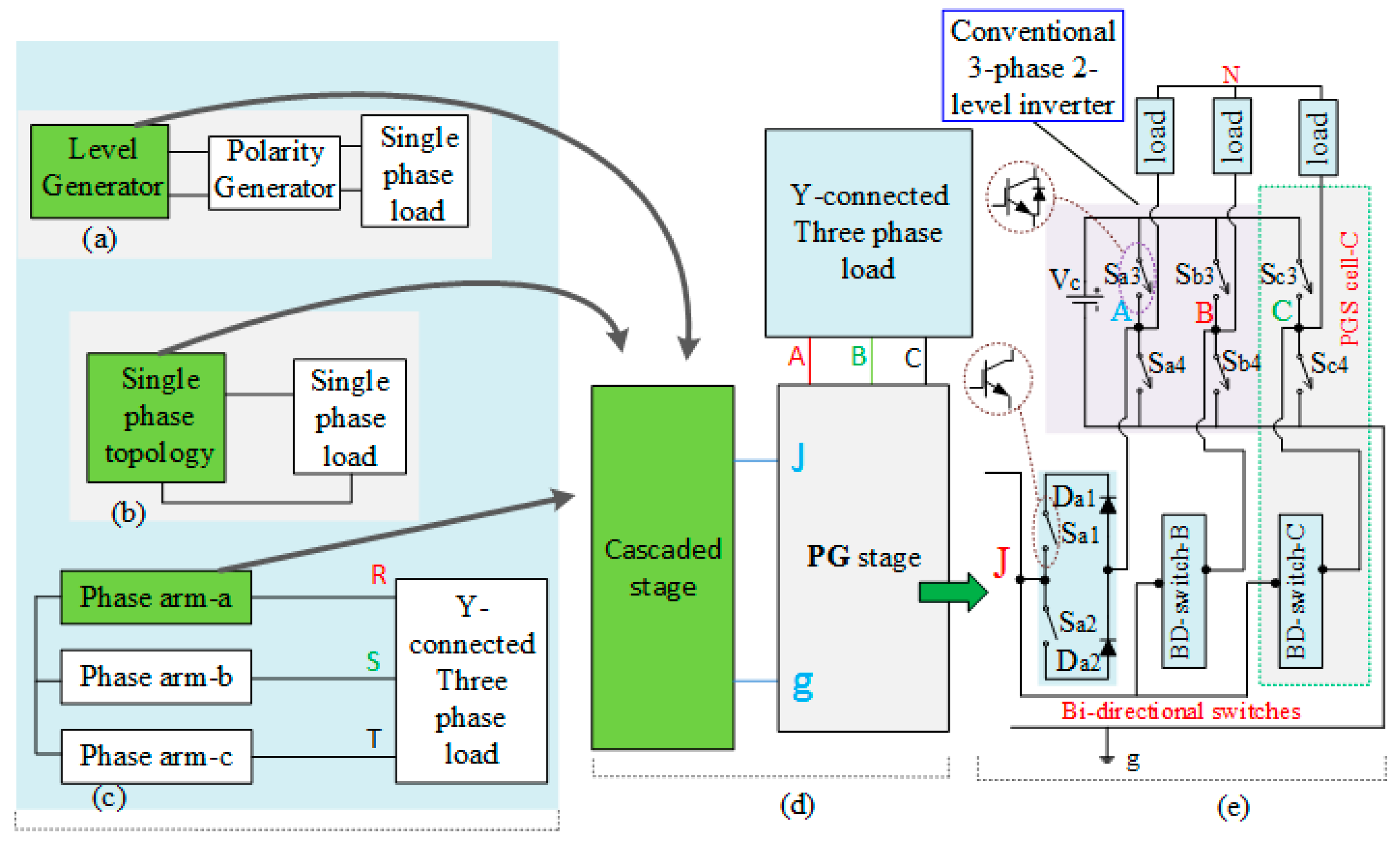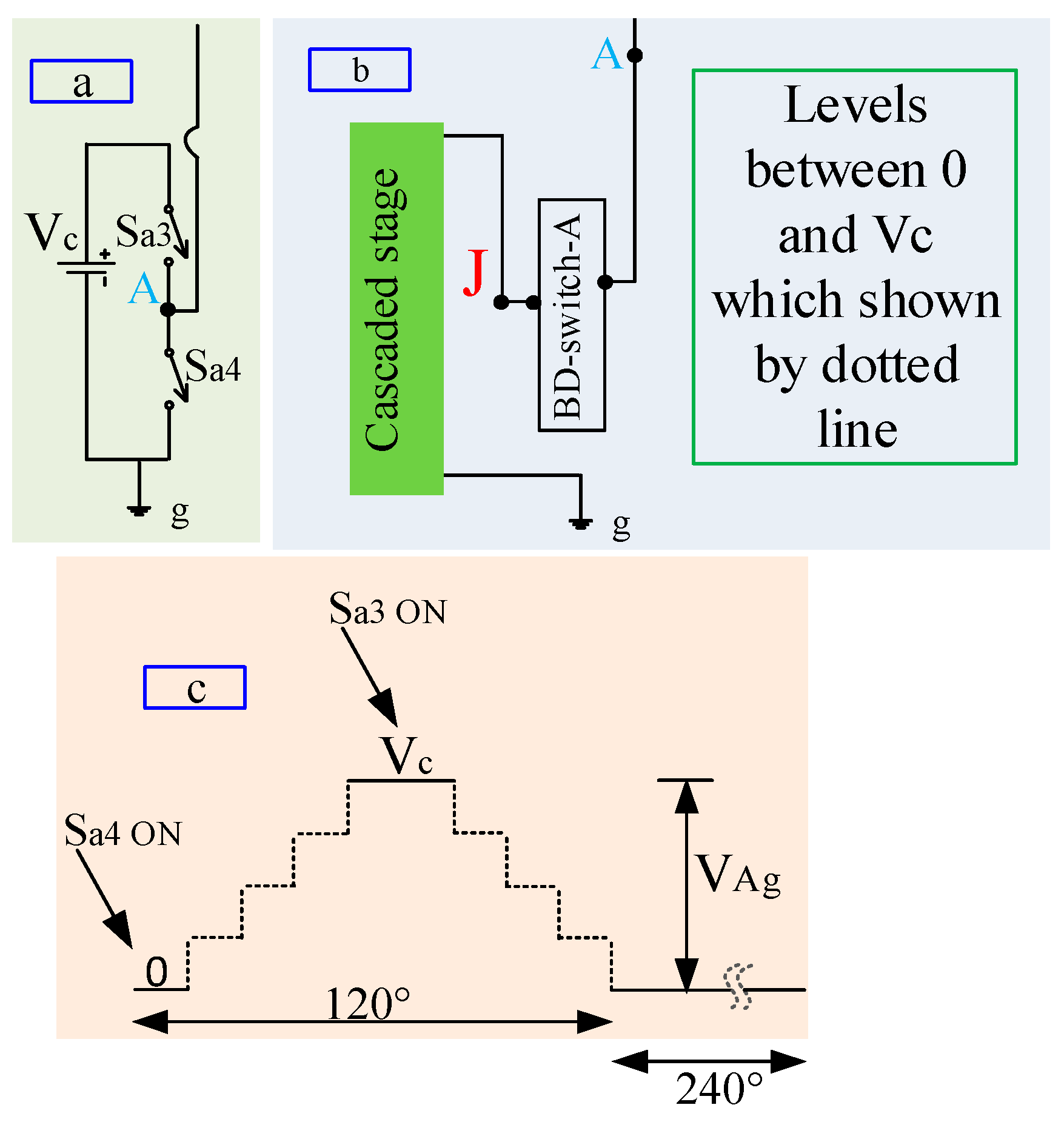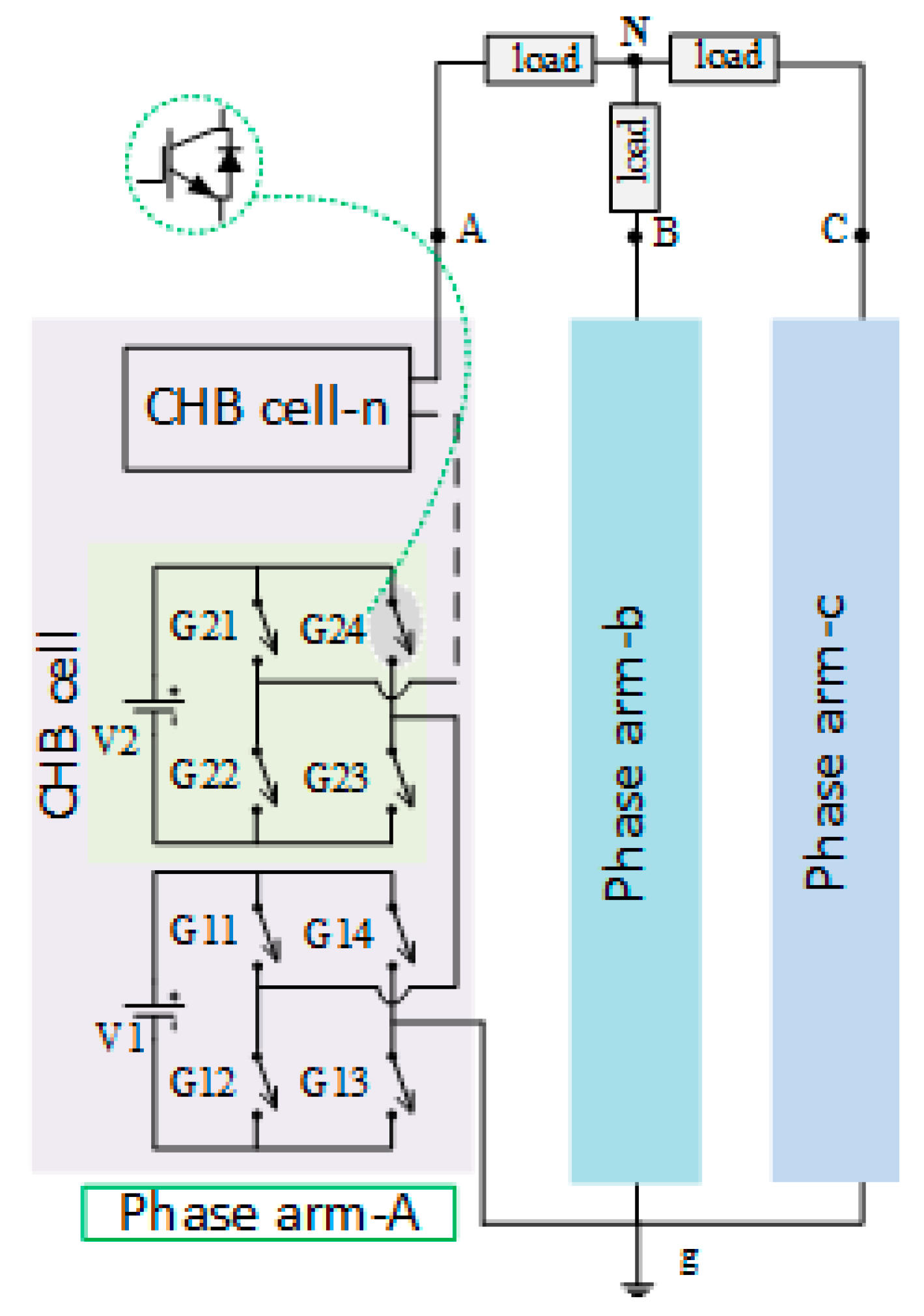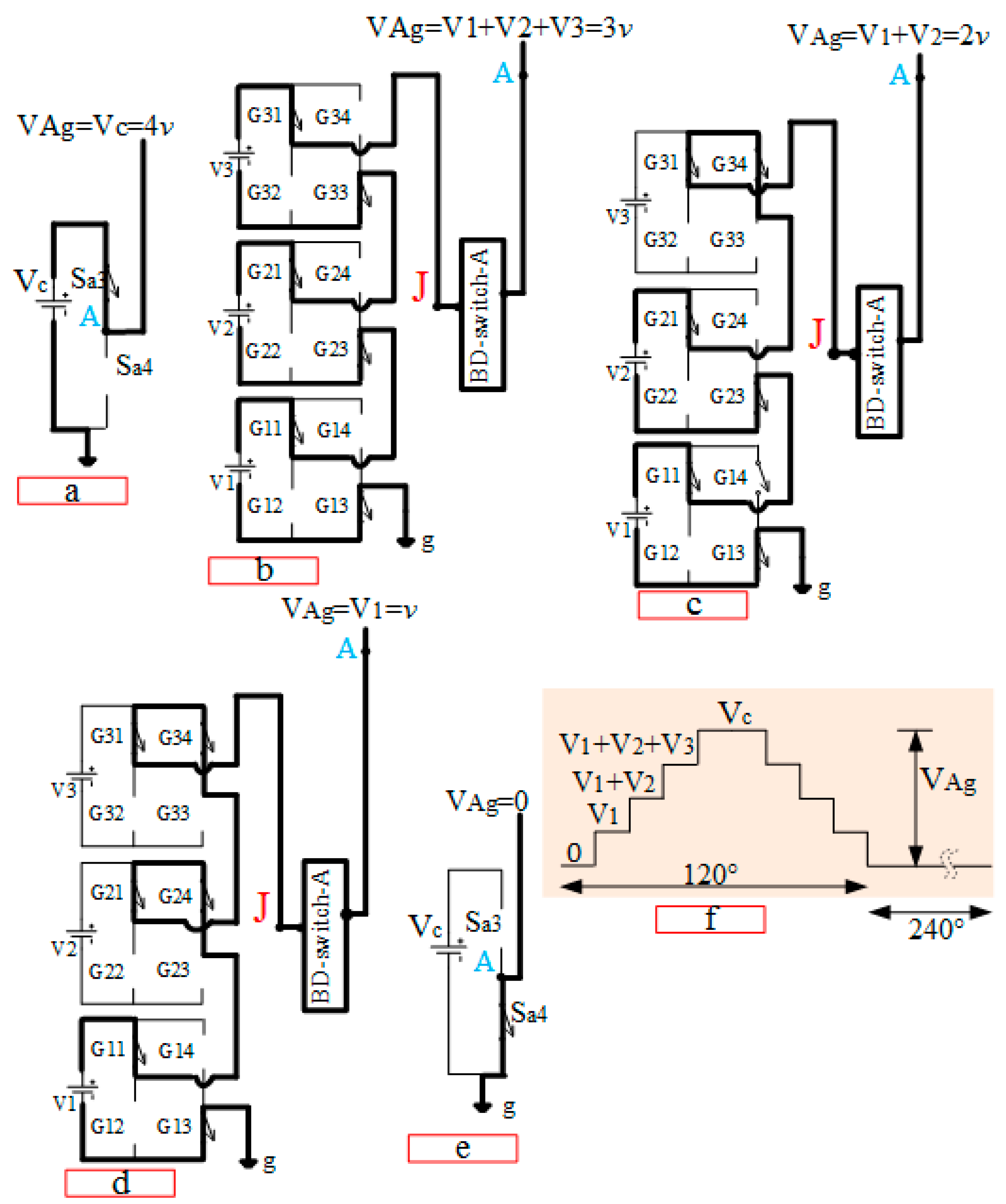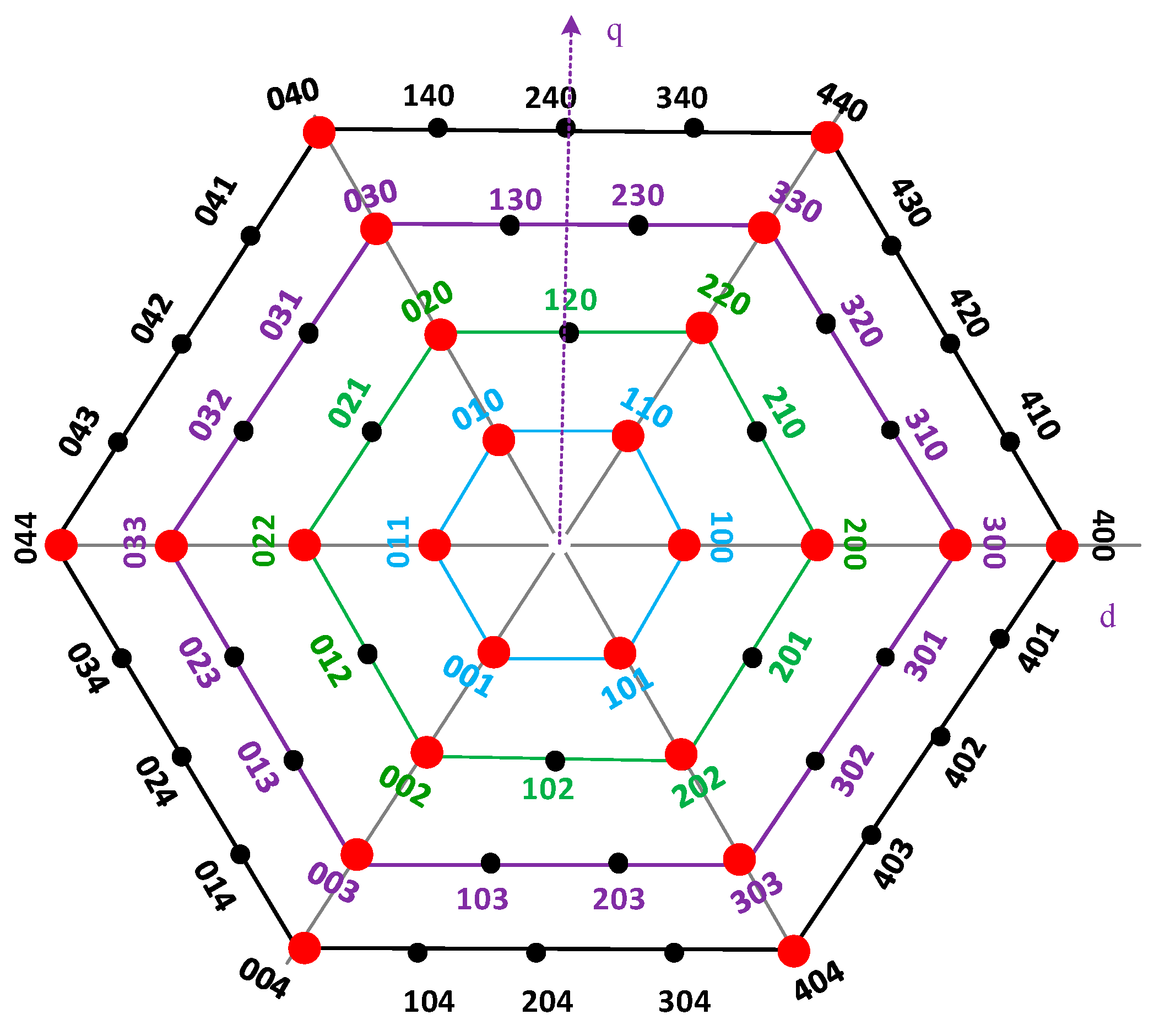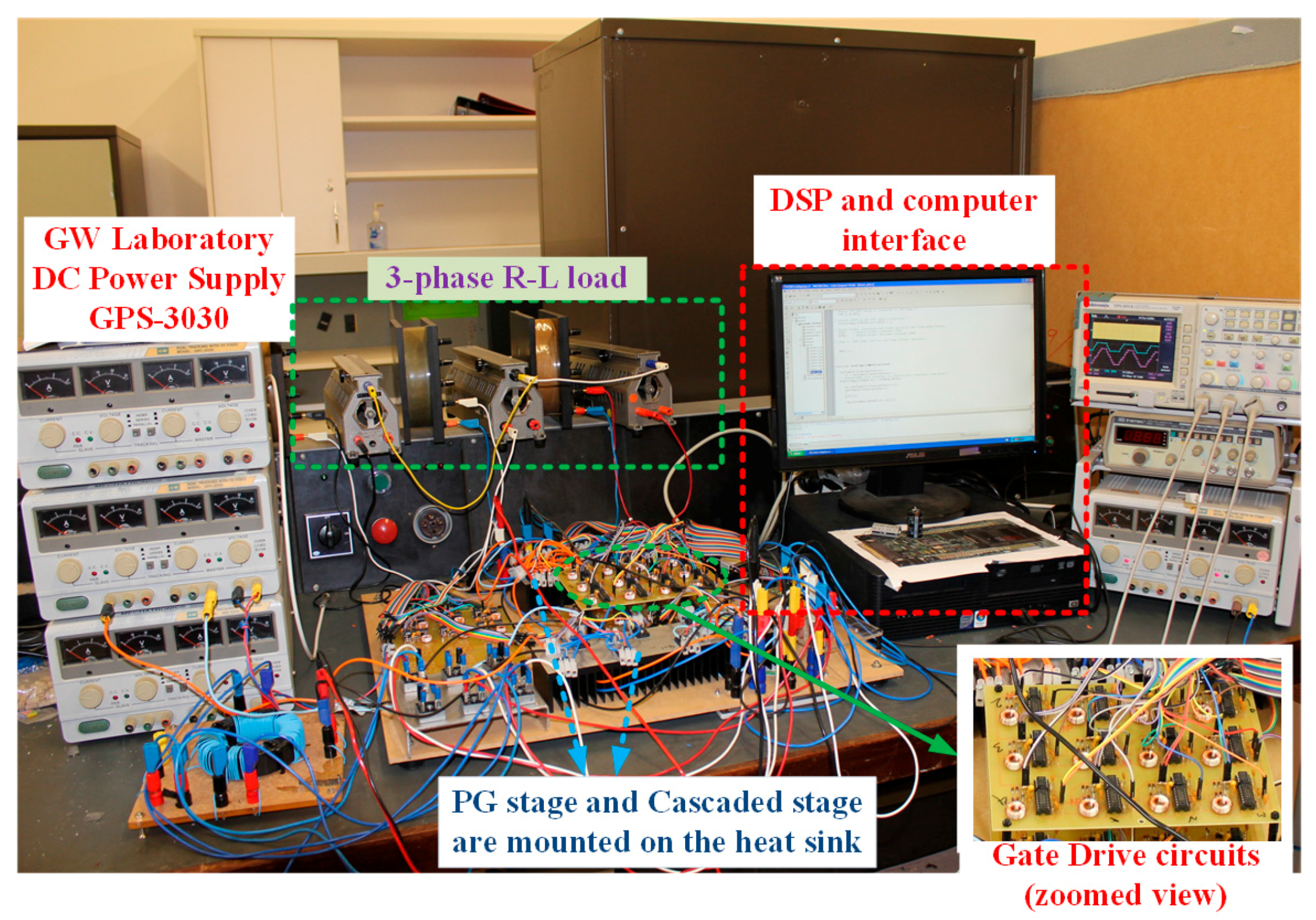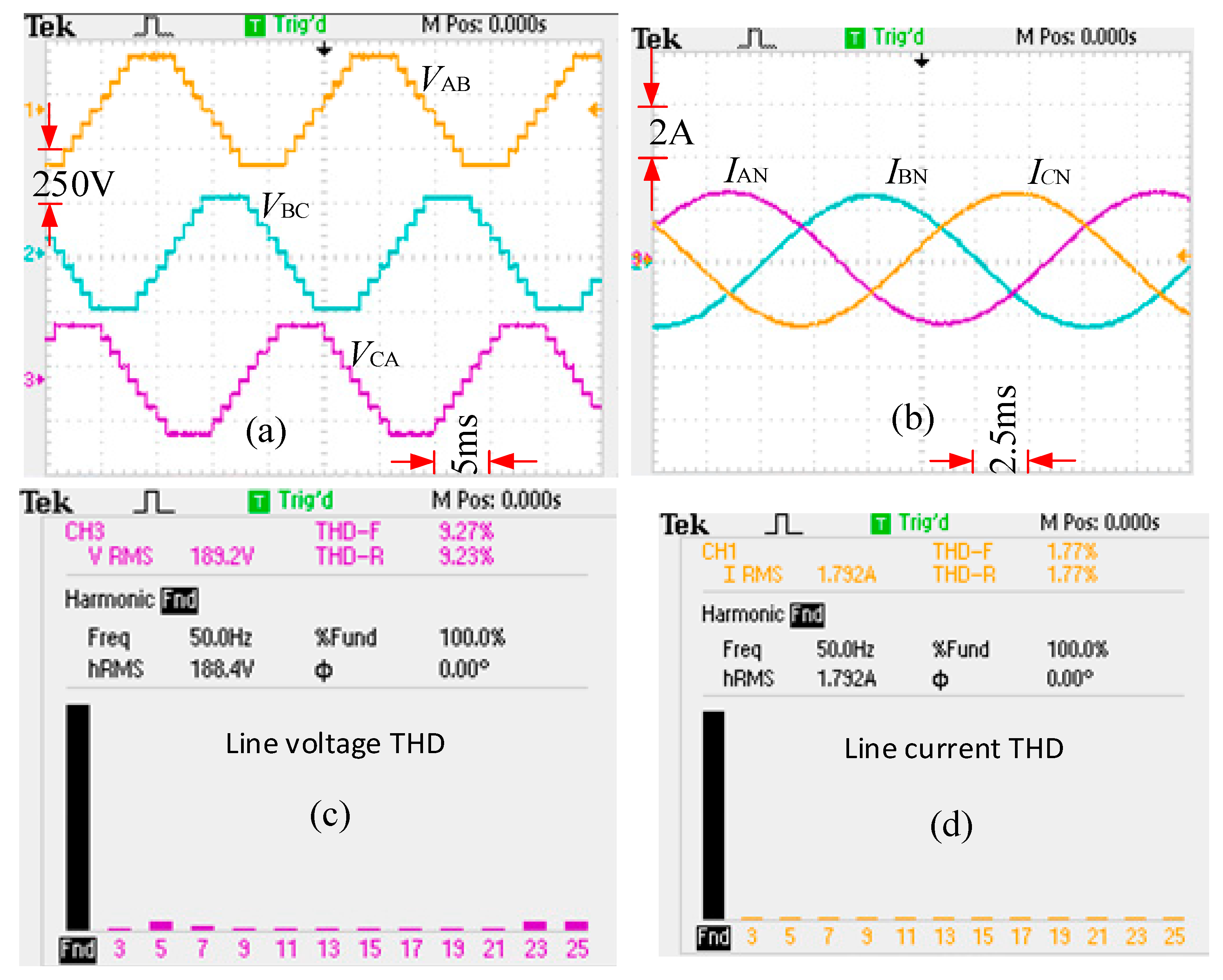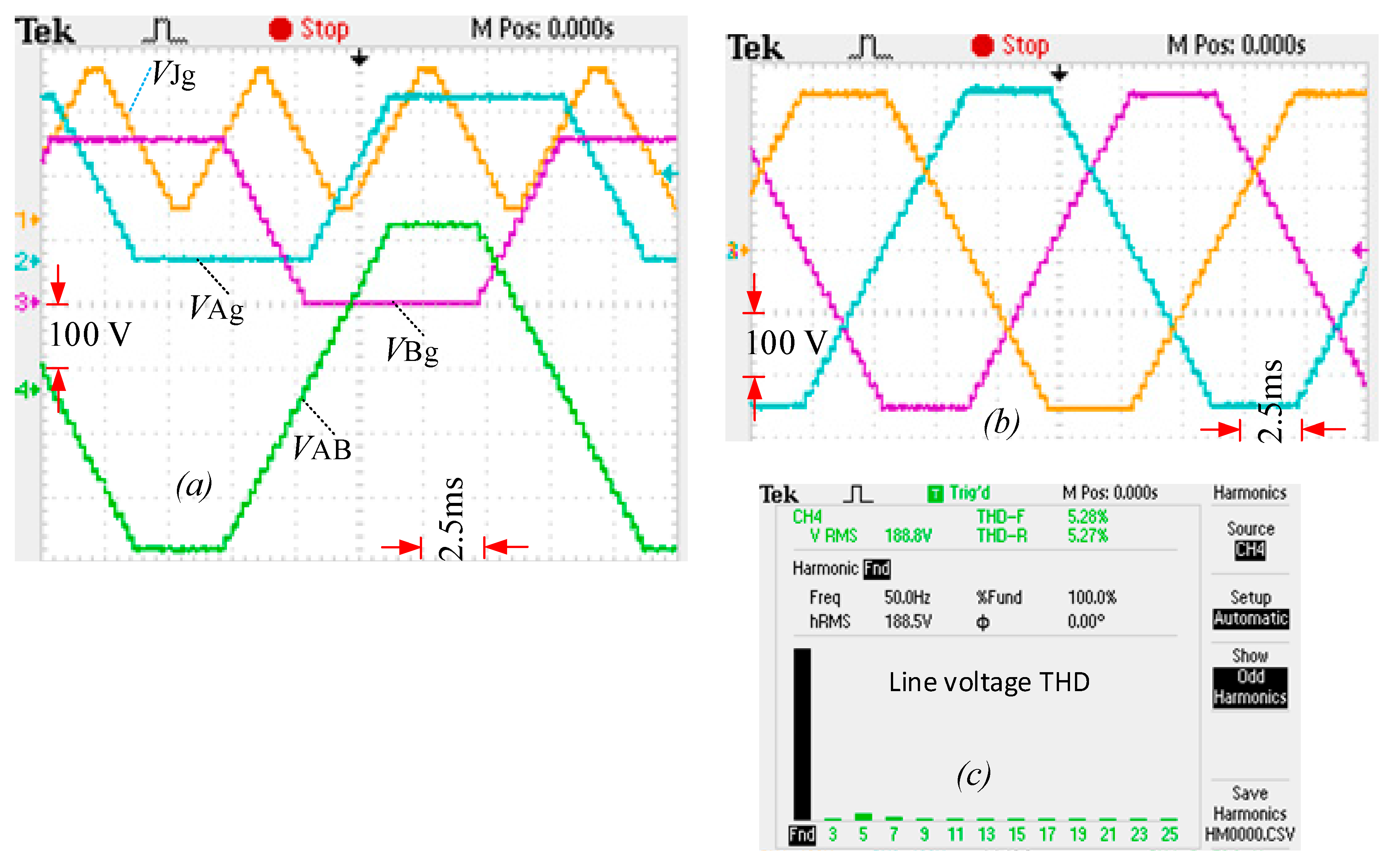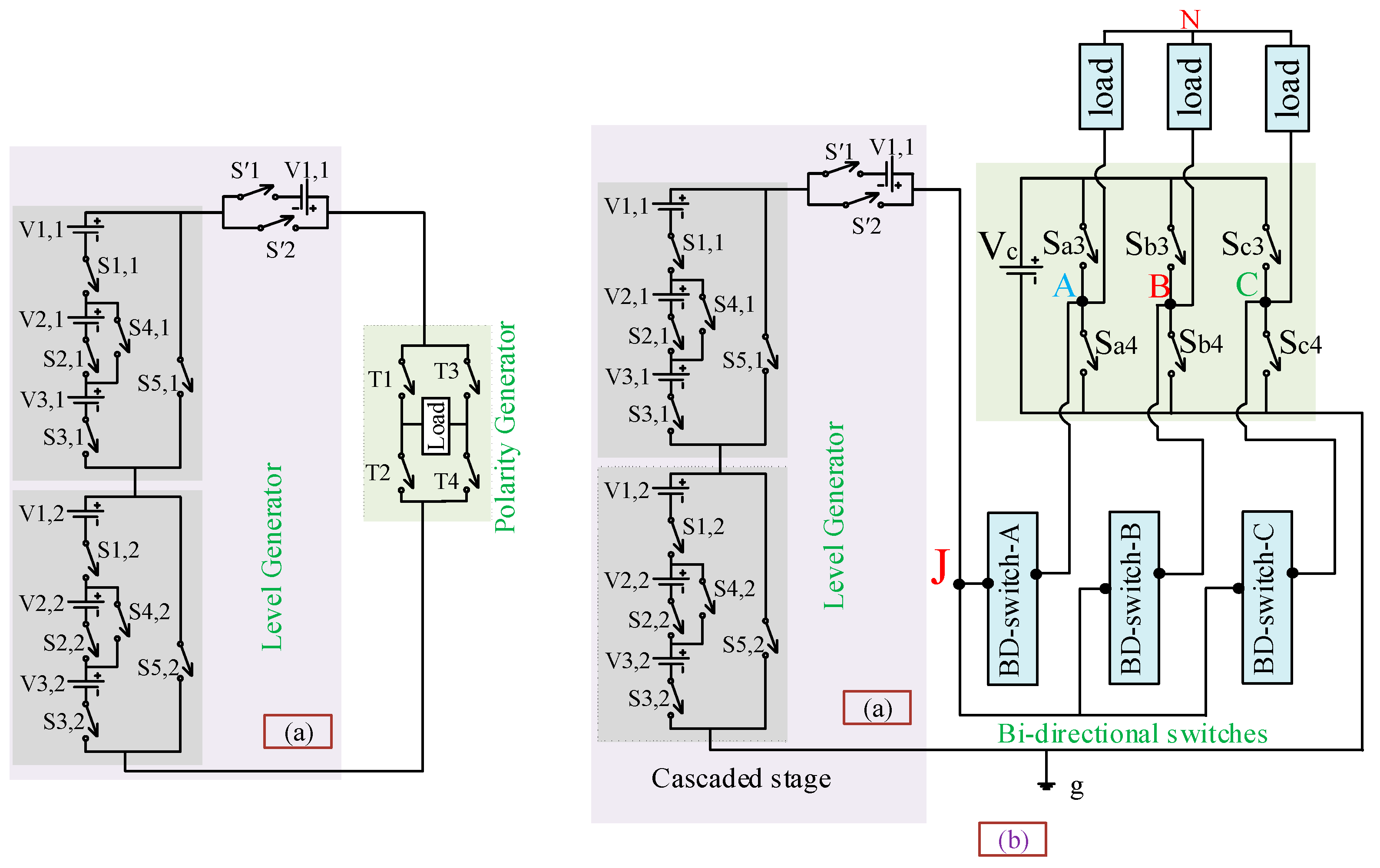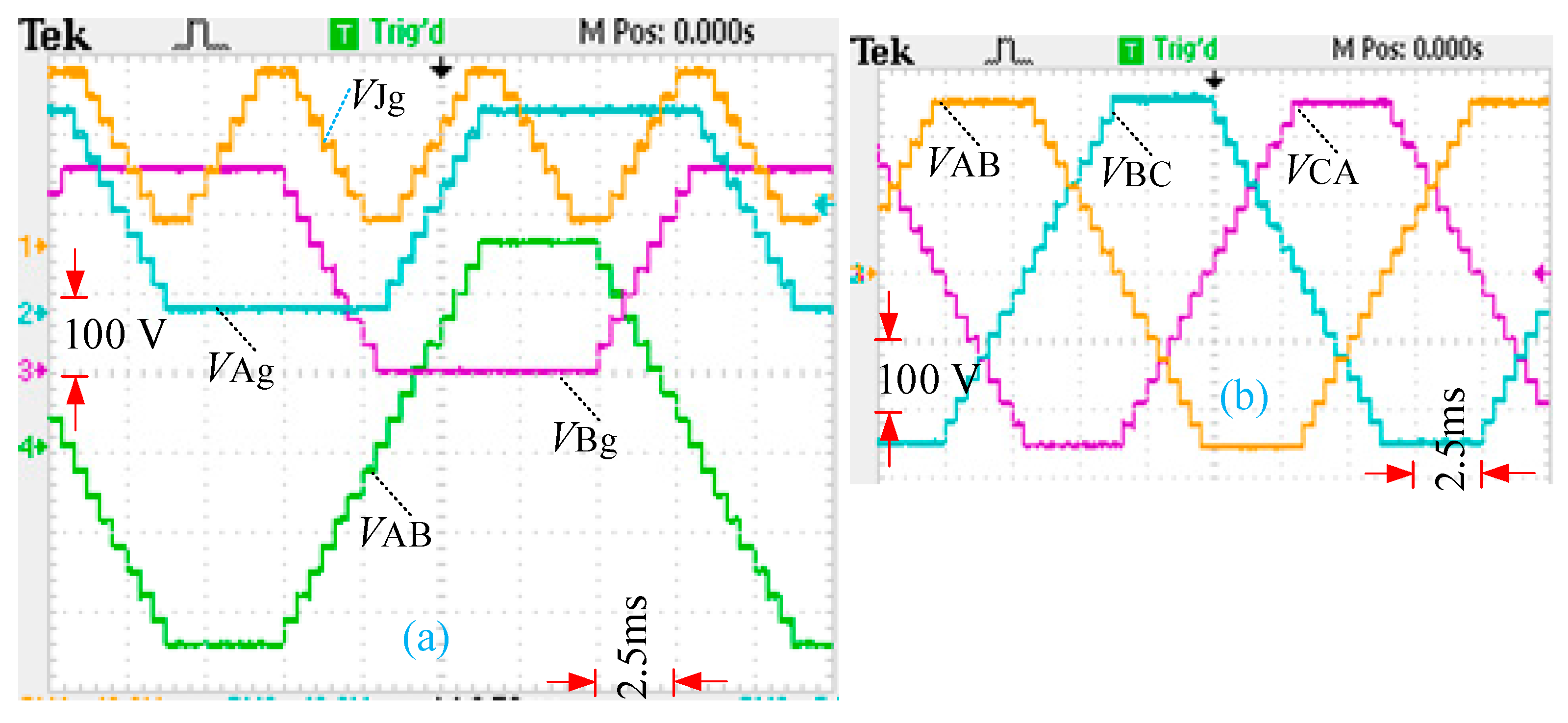1. Introduction
Multilevel inverters (MLIs) have drawn much attention in renewable, vehicular and industrial applications [
1,
2,
3,
4,
5,
6]. Also, MLIs have been utilized in flexible AC transmission, heating and air conditions [
7]. Conventional MLIs include diode clamped or neutral point clamped (NPC), flying capacitor (FC) and cascaded H-bridge (CHB) MLI. Among these types, CHB MLI has been found very reliable in high voltage/high power applications (6.6–13.8 kV, 500 MVA) [
8,
9]. Several research efforts have been conducted to reduce the number and complexity of DC voltage supplies management [
10,
11].
Extensive research can be found in the literature to reduce the device count of cascaded MLI (CMLI). Several cascaded MLI topologies comprise two main parts; level generator and polarity generator as shown in
Figure 1a can be found in the literature [
12,
13,
14,
15]. The level generator is a cascaded connection of a number of inverter cells that generates multilevel unipolar voltage while the polarity generator converts this unipolar voltage into bipolar voltage waveform [
13]. While level generator structure varies for different topologies, the structure of polarity generator has been always an H-bridge connection involving four semiconductor switches. The number of cascaded cells in the level generator may be increased and/or asymmetric input voltage sources can be used to enhance the number of levels in the output voltage waveform without any change to the polarity generator [
12]. The level generator switches may work with high frequency, but the polarity generator switches always function at line voltage frequency [
13].
Other CMLI topologies which are able to generate bipolar voltage without using polarity generator as shown in
Figure 1b were proposed in the literature [
16]. CMLI topologies such as cross-switched and modified H-bridge topologies were also recently proposed in the literature [
17,
18,
19,
20,
21,
22,
23]. Among the above mentioned CMLI topologies, some were mainly developed for three-phase multilevel voltage generation and cannot be directly utilized for single phase applications e.g.,
Figure 1c [
24,
25].
Three-phase CMLI has been widely used in large-scale renewable energy applications to comply with the high-power conversion requirement [
1,
2,
3,
4]. In order to improve the quality of the output voltage waveform, the number of components required to implement the three-phase CMLI should be significantly increased which increases the implementation cost, inverter physical size and complicates the control system. Although several topologies have been proposed in the literature in order to reduce the device count and increase the number of levels in the output voltage of single phase CMLIs, the majority of these topologies have not been extended to three-phase structure yet. It is a common trend that the number of components of single phase topologies is tripled when they are extended to three-phase structures [
13,
14,
26,
27,
28].
Both high frequency and low frequency modulation techniques have been reported as reliable control strategies for CHB MLI [
29,
30]. The most common high frequency modulation strategy is carrier-based sine pulse width modulation (SPWM) strategy and a wide range of carrier frequency (1–12 kHz) is employed to get the switching pulses [
27,
28,
31,
32]. The main problem of SPWM strategy is that it has severe consequences on switching losses [
33]. On the other hand, low frequency modulation strategies provide better output voltage waveform with low total harmonic distortions (THD) [
25,
34].
The main goal of this paper is to introduce a new generalized CMLI topology that could be employed to extend any existing single-phase CMLI topology to a three-phase structure without tripling the devices used within the single-phase structure. The proposed topology can also be employed by existing three-phase CMLI topologies to reduce its device count without compromising its performance. Besides, a low frequency space vector modulation (SVM) technique is applied to generate switching pulses. The proposed topology provides an optimized design solution to CMLI in terms of reducing the implementation cost and physical size while maintaining the quality of the output voltage waveform.
2. Proposed Concept of 3-Phase CMLI
Figure 1d shows the block diagram of the proposed three-phase CMLI, in which a cascaded stage is connected with the polarity generator (PG) stage at junction point ‘J’. The structure of the cascaded stage is not fixed as it can be replaced by any existing cascaded MLI topology. The green shaded portions of existing CMLI topologies in
Figure 1a–c can be employed as a cascaded stage in the new proposed topology. The PG stage is developed by utilizing three Bi-directional (BD) switches and a conventional three-phase two level inverter (CTPTLI). Each BD switch consists of two insulated gate bipolar transistors (IGBT) and two diodes. Both IGBT switches work simultaneously to turn the BD on or off. Three-phase arms A, B, and C exist in the PG stage. A BD switch and two switches in the CTPTLI can be considered as a PG cell in each phase arm with 120° phase difference among the switching devices of the three cells. The CTPTLI is fed by a dc-voltage supply ‘
VC’ of a magnitude greater than the summation of the input voltage supplies in the cascaded stage.
Each pair of the switches, (Sa3, Sa4), or (Sb3, Sb4), or (Sc3, Sc4) within the CTPTLI at different PG cells are responsible for generating VC and zero voltage levels in the output voltage waveform at the output nodes A, B, C. For any PG cell, the PD-switch is turned off while the two switches within the CTPTLI operate to generate VC and zero voltage level. The pair switches in the CTPTLI and the BD switch always function in a toggle mode. As mentioned above, any existing CMLI topology can be utilized as a cascaded stage and, hence, no significant change is required in the switching logic for existing CMLI topology when used as a cascaded stage to generate different voltage levels in the proposed topology.
In any PG cell, the PD-switch is only turned on for conducting the voltage levels, which are generated by the cascaded stage to the output points A, B, C. Three BD-switches, which are connected with the cascaded stage at the junction point ‘J’ as shown in
Figure 1e are operated with a 120° phase difference.
Figure 2a shows the simplified structure of the PG stage for generating the voltage levels
VC and 0 in the pole voltage
VAg which are achieved by toggle operation of switches
Sa3 and
Sa4.
Figure 2b shows the conduction path of the inverter when it generates intermediate levels between
VC and 0 in the pole voltage.
Figure 2c shows the final pole voltage.
If VAg, VBg, VCg are the pole voltages, then the line voltage, VAB, VBC, VCA can be derived as below,
3. Proposed CMLI Using H-Bridge Topology as Cascaded Stage
Cascaded H-Bridge (CHB) MLI topology is a well-established structure for single and three-phase applications [
35]. The cascaded stage in the proposed generalized CMLI is facilitated to utilize any single- or three-phase structure as shown in
Figure 1.
The conventional CHB MLI topology shown in
Figure 3 for n-number of CHB cells is chosen to validate the proposed three-phase inverter concept. The proposed three-phase MLI structure involving three CHB cells in the cascaded stage is shown in
Figure 4a.
The number of CHB cells in the cascaded stage can be increased in order to achieve more levels in the output voltage waveform. Each H-bridge cell (k) comprises four switches (
Gk1,
Gk2,
Gk3,
Gk4) and a dc-power supply (
Vk) as depicted in
Figure 4b. Any CHB cell is able to produce three different voltage levels (
Vk, 0, −
Vk) in the output voltage,
Vout.
Table A1 in the
Appendix A shows the switching logic to achieve the aforementioned three output voltages.
Symmetric and asymmetric structures are proposed for conventional CHB MLI topology in [
35,
36], respectively. Asymmetric methods are found superior than the symmetric in terms of the number of levels in the output voltage as presented in [
35]. In [
37], an asymmetric CHB MLI is presented, where the dc voltage ratios are kept in binary form (1:2 … 2
n). The Trinary ratio format (1:3: … :3
n) has been also proposed for CHB MLI asymmetric structure [
38]. The new proposed three-phase CMLI concept in this paper can adopt both symmetric and asymmetric structure of the CHB MLI in the cascaded stage.
As mentioned above, the magnitude of the
VC should be greater than the summation of the connected voltage supplies in the cascaded stage. If
V1,
V2, …,
V3 are the input voltages for n-number of cells in the cascaded stage, then the following respective equations for symmetric, binary-related and trinary-related input supplies can be written,
where ‘
v’ is the per unit voltage value.
The input voltage-supply of the CTPTLI, VC can be calculated from,
Figure 5 shows the conduction path for generating the pole voltage. In
Figure 5, the magnitudes of the CHB cells input voltage supplies are considered symmetric i.e.,
V1 =
V2 =
V3 =
v;
VC = 4
v. With the contribution of CTPTLI and CHB cells along with the BD-switches, pole voltages,
VAg,
VBg,
VCg are produced. Only the CTPTLI switches operate to generate the voltage levels,
VC and 0 as shown in
Figure 5a,e, respectively. The other voltage levels, (
V1 +
V2 +
V3), (
V1 +
V2),
V1 between 0 and
VC levels are produced using different switching logics among the CHB cells, when the BD-switches are turned on.
Figure 5e shows the pole voltage output,
VAg, which can be obtained by the above mentioned switching operation.
While
Figure 5 explains the generation of one arm pole voltage,
VAg; the other two pole voltages follow the same switching logics with 120° phase shift among the PG-cells. The switching function for each phase arm lasts for 120° phase angle.
4. Implementation of the Proposed MLI
The proposed MLI topology in
Figure 4 is controlled with a low frequency staircase modulation strategy [
39,
40]. The switching states follow a specific sequence in the d-q plane. The number of switching states,
S in the d-q plane is an essential factor to generate the output voltage levels and can be expressed as,
where
NP is the number of levels in the pole voltages.
The number of switching states forms different hexagons as shown in
Figure 6 to achieve different number of levels in the pole voltage waveforms.
In
Figure 6, the smallest hexagon represents the switching states for
NP = 2 and the following hexagons is for
NP = 3,
NP = 4, and
NP = 5; respectively. According to
Figure 5, the proposed topology generates
NP = 5 in the pole voltages. Hence, the most upper hexagon in
Figure 6 is appropriate for getting 24 switching states to generate five voltage levels, 4
v, 3
v, 2
v,
v, 0 in the pole voltages.
The 24 switching states are, 044, 043, 042, 041, 040, 140, 240, 340, 400, 430, 420, 410, 400, 401, 402, 403, 404, 304, 204, 104, 004, 014, 024, 034. Each of the switching states has three switching vectors,
Sa,
Sb,
Sc for three-phase voltage generation. The pole voltages,
VAg,
VBg,
VCg are taken as reference to achieve the three switching vectors in each switching state at any instant of time [
39]. In general, the switching angles,
φ for each of the switching states are equal and can be calculated from,
Hence, the switching angle of each of the 24 switching state is 15°. This means, a new switching state will come into operation every 15°. In the switching sequence of 24 switching states, the switching vectors 4, 3, 2, 1, 0 are combined in an organised manner to generate three pole voltages and the switching vectors always abide by
Table A2 in the
Appendix A for different voltage level generation.
The real time switching signals are obtained using digital signal processor, TMS320F2812 (Texas Instruments, Dallas, TX, USA). The implementation requires 12 IGBTs for three CHB cells in the cascaded stage and 12 IGBTs in the PG cells. A laboratory prototype is developed to validate the feasibility of the proposed inverter.
Figure 7 shows the developed hardware prototype model. A total of 21 general-purpose input/output (GPIO) pins are required in the DSP, TMS320F2812 for achieving all real-time switching signals. Sixteen (GPIOA0-GPIOA15) pins are chosen from GPIO-A while the remaining one pin is chosen from GPIO-B (GPIO B0) pin array. The gate signals of phase B and C within the three PG-cells have similar pattern as in phase-A with a phase shift of 120° and 240°, respectively.
Six IGBTs, IRG4BC40W, 600 V/20 A along with six diodes, RHRP1540, 400 V/15 A are used for the three BD-switches in the PG-stage while 18 IGBTs, HGTG20N60B3D, 600 V/40 A are used to build the CHB cells in the cascaded stage and CTPTLI. A four channel digital storage oscilloscope, Tektronix TPS 2014 (Tektronix Inc., Beaverton, OR, USA) is utilized to capture the experimental output waveforms and analyse total harmonic distortion (THD).
5. Results and Discussions
Table A3 in the
Appendix A shows system specification of the implemented inverter. To validate the feasibility of the proposed topology, its performance in terms of output voltage/current waveforms along with the THD has been compared with the performance of the MLI topology presented in [
5,
40]. As will be elaborated below, while the proposed topology in this paper can reduce the MLI device count significantly, it almost provides the same performance of the MLI topology presented in [
5,
40]. Results in various test cases are demonstrated in the following sub-sections.
A. H-bridge cells symmetric input supplies
The input dc-voltage sources are connected such as V1 = V2 = V3 = v = 70 V and VC = 4v = 280 V. Inductive 3-phase load (Z = 55 + j 37.68 Ω/phase) is considered for testing the inverter performance.
Figure 8a shows the junction voltage,
VJg and pole voltages,
VAg,
VBg,
VCg, respectively. As shown in the figure, the pole voltages comprise five levels (280 V, 210 V, 140 V, 70 V, 0) while
VJg comprises three levels (210 V, 140 V, 70 V).
Figure 8b,c show the load voltages,
VAN,
VBN,
VCN, and their THD, respectively. The relation between the pole voltages
VAg,
VBg,
VCg, and load voltages can be expressed by,
On the other hand, the line voltages,
VAB,
VBC,
VCA shown in
Figure 9a comprise nine levels (280 V, 210 V, 140 V, 70 V, 0 V, −70 V, −140 V, −210 V, −280 V).
Figure 9b shows the three-phase line currents,
IAN,
IBN,
ICN. It is worth mentioning that no harmonic filter was used in the implemented hardware setup. The total harmonic distortion (THD) of the unfiltered line voltage and line current are 9.27% and 2.09%; respectively as shown in
Figure 9c,d, respectively. The THD of the line current and voltage must be less than 5%, to comply with the IEEE standard [
41]. While the current THD complies with the mentioned standard, voltage THD is more than 5% in the implemented 9-level CMLI topology. Voltage THD can be reduced by increasing the number of levels in the output voltage.
B. H-bridge cells Trinary-related input supplies
In the proposed topology, the number of levels in the output voltages can be increased by considering asymmetric trinary ratio for the input dc supplies. According to (3) the magnitudes of V1, V2, V3 are set to 20 V, 60 V, 180 V; respectively and hence the magnitude of VC is 280 V.
This configuration is able to generate 15-levels (
NP = 15) in the pole voltage and 29-levels in the line voltage. Hence, it needs 84-switching states to generate three-phase output voltages according to (5).
Table A4 in the
Appendix A shows the switching logics for generating 15 levels in the pole voltage. The junction voltage, and line voltage,
VAB are shown in
Figure 10a.
Figure 10b shows 29-level three-phase line voltages on the same plot. The THD of the unfiltered 29-level line voltages is nearly 5% as shown in
Figure 10c.
C. Three-phase conversion of existing single-phase inverter topologies
A number of single phase MLI topologies along with different input voltage algorithms have been recently published [
12,
13,
14,
15,
17,
18,
19,
20,
21,
22,
23]. The proposed three-phase inverter concept in this paper permits easy conversion of the existing single phase MLI into three-phase structures without tripling the number of semiconductor switches and dc-supplies as per the current conventional practice. To do so, only the PG stage in the proposed topology is required to be connected with any existing single phase topology.
To extend any existing single-phase inverter to three-phase structure using the proposed concept, switching logics of the single phase cascaded inverter can be retained.
Figure 11a shows a single phase topology published in [
12] while
Figure 11b shows the extended three-phase structure of this single phase inverter using the proposed concept in this paper. As shown in
Figure 11b, the single phase topology acts as a cascaded stage and generates all possible voltage levels by following the same switching logic proposed in [
12].
The bidirectional and CTPTLI switches operate as shown in
Figure 2. In [
12], the single phase structure produces 15-levels in the line voltage, when
Figure 12a is set with
V11 =
V21 =
V31 =
V21 =
V22 =
V23 =
V’0 = 40 V and
VC = 280 V. The cascaded stage in
Figure 11b is arranged in a similar pattern by imitating the single-phase structure for three-phase conversion.
Figure 11b, the single phase topology acts as a cascaded stage and generates all possible voltage levels by following the same switching logic proposed in [
12]. The bidirectional and CTPTLI switches operate as shown in
Figure 2. In [
12], the single phase structure produces 15-levels in the line voltage, when
Figure 12a is set with
V11 =
V21 =
V31 =
V21 =
V22 =
V23 =
V’0 = 40 V and
VC = 280 V. The cascaded stage in
Figure 11b is arranged in a similar pattern by imitating the single-phase structure for three-phase conversion.
Table 1 provides a comparison of using the concept proposed in this paper and conventional methods to transfer single-phase to three-phase structure.
The table reveals the superior advantages of the proposed concept over existing conventional methods in terms of reducing the number of switches and dc-supplies while increasing the levels in the output voltages when a single phase structure is extended to three-phase one.
The three-phase inverter in
Figure 11b produces nine levels in the pole voltages and 17-levels in the line voltage. It requires 48-switching states to produce these voltage levels according to (5).
Table A5 in the
Appendix A shows the switching logic for this inverter.
Figure 12a shows the junction voltage,
VJg, pole voltages and line voltage,
VAB of the extended three-phase inverter.
Figure 12b shows the three-phase 17-level line voltages on the same plot.
6. Semiconductor Losses and Inverter Efficiency
Semiconductor losses are considered as a crucial design factor for any converter circuit, which influences and defines the required thermal management and contributes to the estimation of overall cost, volume and weight of the inverter. There are two dominant losses in the semiconductor devices; the static and the dynamic losses. The on-state resistance and the forward voltage drop of the semiconductor device are responsible for the static (conduction) losses, while the dynamic losses are produced during the ON-OFF actions dictated by the switching frequency of the device [
39].
The overall semiconductor losses of the proposed CMLI can be estimated by the total conduction and switching losses of all used semiconductors as below:
If the output power is
Pout, the inverter efficiency (
ƞ) can be calculated from:
The output power is calculated from:
where
VC and
Iline are the input voltage to the CTPTLI and output line current, respectively.
The proposed topology (
Figure 4b) in this paper utilizes IGBT with anti-parallel diode (HGTG20N60B3D) in the cascaded structure and IGBT (IRG4BC40W) along with diode (RHRP1540) in the PG structure. The following parameters are used to calculate the switching losses;
VT = 1.8 V,
RT = 0.10,
VD = 1.2 V,
RD = 0.1,
β = 1,
ton =
toff = 1 µs. where, the on-state voltage drop of the transistor and diode are expressed by
VT and
VD, respectively. The on-state resistances of the transistor and diode, are given by
RT and
RD, respectively. The transistor amplification factor and ON-OFF time is expressed by ‘
β’,
ton and
toff, respectively.
Total switching loss is found to be Ptotal_loss = 2.9067 watt with 1.3076 watt losses associated in the cascaded stage and 1.5991 watt in the PG stage. For a connected load of 0.82 lagging power factor (PF) and by using (15), the output power is 98.64 watt which gives an overall efficiency of about 97%.
